April 2022
The universe through the eyes of the James Webb Space Telescope

Friday, April 29, 2022: NASA has released a batch of images acquired by the James Webb Space Telescope, which is in the final stages of its post-launch commissioning phase.
The images show that the telescope's instruments are aligned and nearly ready to start delivering the ground-breaking science the telescope was built for. – Tereza Pultarova
Crew-4 celebrates arrival at space station

Thursday, April 28, 2022: European astronaut Samantha Cristoforetti is receiving a warm welcome from the International Space Station crew as she arrives to begin her rotation together with her Crew-4 mates.
Crew-4 arrived at the orbital outpost on Wednesday (April 27) at around 7:37 p.m. EDT (2337 GMT) after what was described as the quickest ever trip to the space lab.
In addition to Cristoforetti, NASA astronauts NASA's Kjell Lindgren, Bob Hines and Jessica Watkins were on board of the Dragon Freedom crew capsule, which launched atop SpaceX's Falcon 9 rocket on Wednesday morning from NASA's Kennedy Space Center in Florida. – Tereza Pultarova
SpaceX Dragon Freedom capsule ready for Crew-4 launch
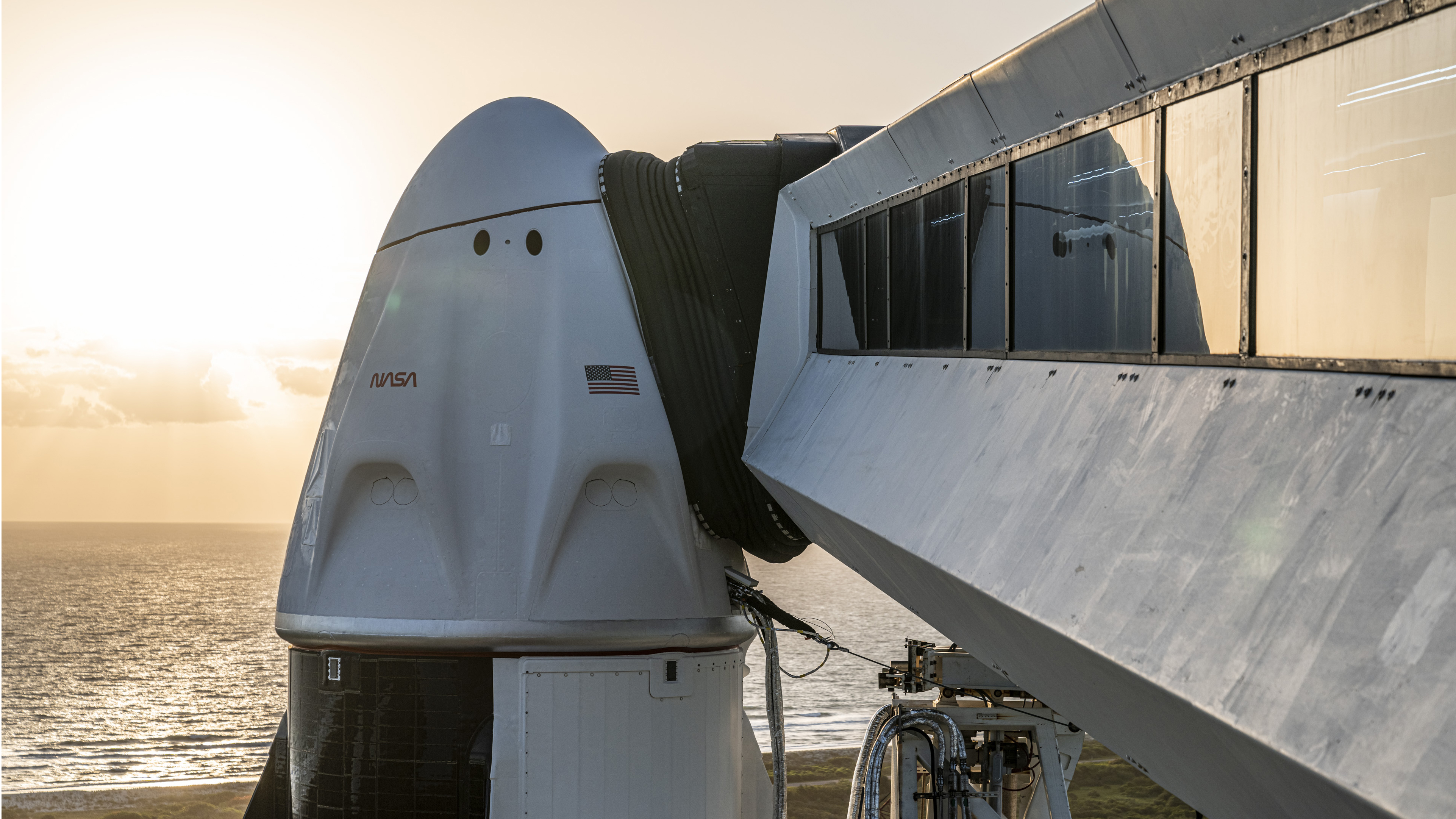
Tuesday, April 26, 2022: The SpaceX Dragon Freedom space capsule sits atop the Falcon 9 rocket at NASA’s Kennedy Space Center in Florida one day ahead of the launch of the Crew-4 mission to the International Space Station.
The capsule will take to the orbital outpost NASA astronauts Kjell Lindgren, Robert Hines, Jessica Watkins, and the European Space Agency's Samantha Cristoforetti. The four will replace Crew-3 astronauts Raja Chari, Thomas Marshburn and Kayla Barron (of NASA), and ESA's Matthias Maurer.
Get the Space.com Newsletter
Breaking space news, the latest updates on rocket launches, skywatching events and more!
The mission will lift off from Launch Complex 39A (LC-39A) on Wednesday (April 27) at 3:52 a.m. ET (7:52 GMT). – Tereza Pultarova
Axiom private space farers return home

Monday, April 25, 2022: Astronauts of the private Axiom-1 mission to the International Space Station are finally returning home after a delay caused by bad weather at the landing site.
The SpaceX Dragon Endeavor capsule with the four crew-members aboard undocked from the orbital outpost on Sunday (April 24) at 9:10 p.m. EDT (1310 GMT on April 25) after a 16-day stay. The mission, the first privately funded U.S. space tourism mission to the ISS, was originally expected to leave the station on Saturday (April 23).
The capsule is expected to splash down later today off the Florida coast. – Tereza Pultarova
Earth on Earth Day
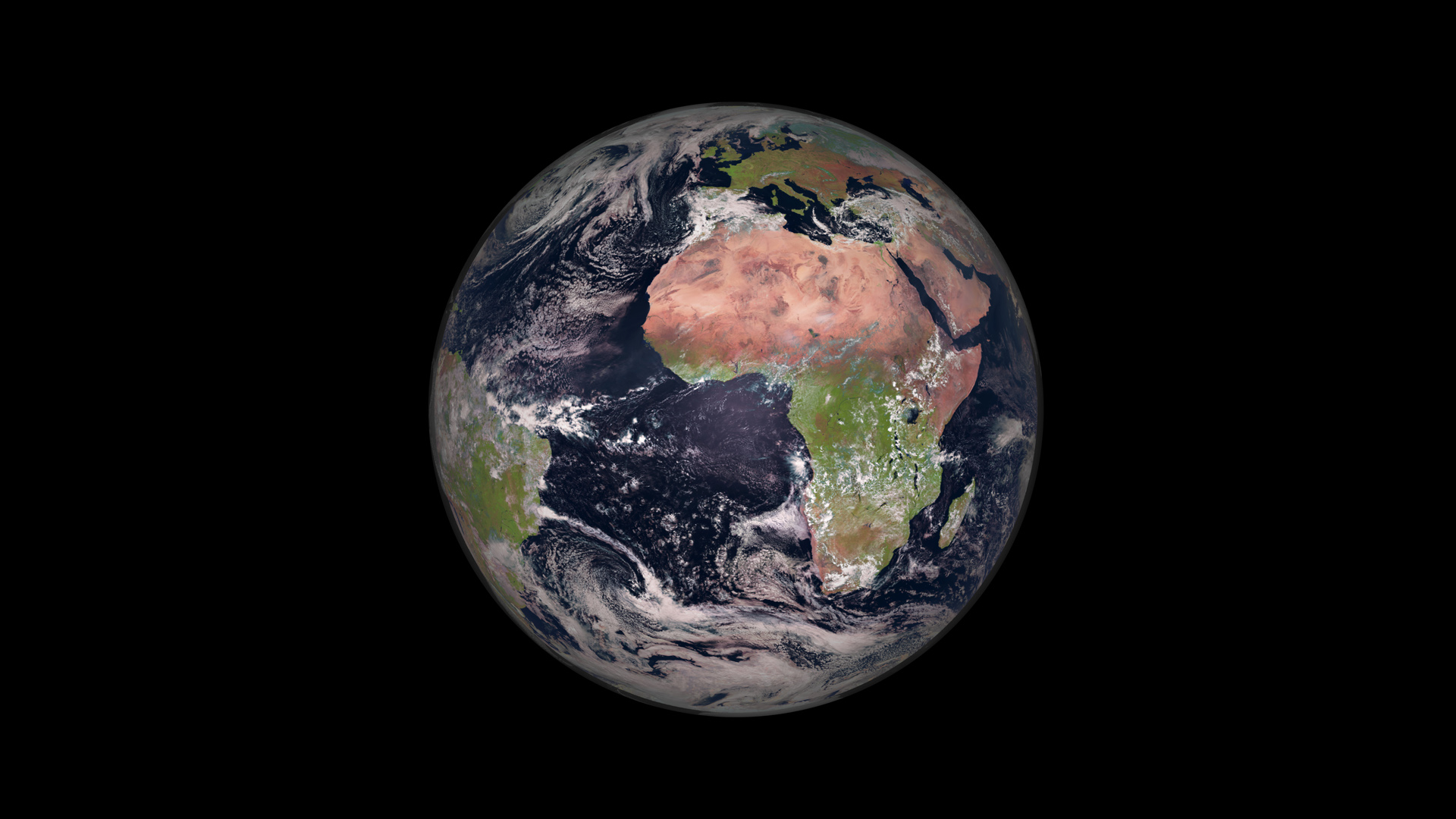
Friday, April 22, 2022: The European Meteosat weather satellite has captured this image of Earth from its vantage point 22,000 miles (36,000 kilometers) above the planet on March 23.
The European Space Agency (ESA), which co-develops the Meteosat satellites for the European Organisation for the Exploitation of Meteorological Satellites (EUMETSAT), released the image on Friday (April 22) as part of the Earth Day celebrations.
Celebrated since 1970, the Earth Day is becoming an increasingly solemn event as reports of worsening symptoms of climate change keep coming from the global scientific community.
A report released today by the European environment program Copernicus, for example, stated that atmospheric concentrations of methane and carbon dioxide, the two most troubling greenhouse gasses, have reached new record levels in 2021. – Tereza Pultarova
Tonga islands recovering three months after volcanic eruption
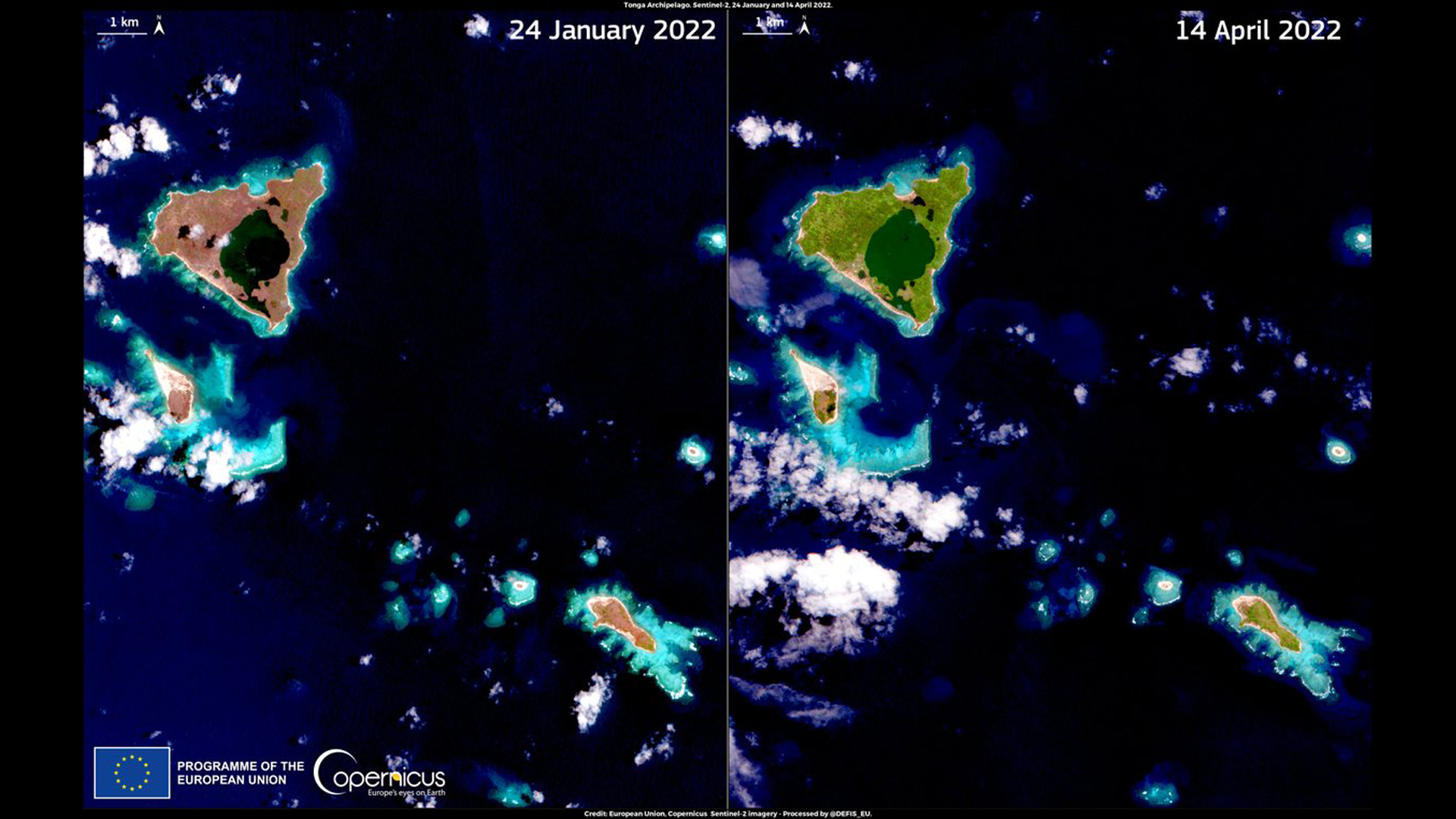
Thursday, April 21, 2022: Islands in the Kingdom of Tonga in the southern Pacific Ocean are recovering after a devastating volcanic eruption that rippled through the region in January, satellite images reveal.
The image above compares the situation in Tonga on January 24, ten days after the Hunga Tonga Hunga-Hunga Ha'apai volcano blasted thousands of tonnes of dust and lava into the atmosphere, with the state of the islands on April 14, exactly three months after the eruption.
Both images were captured by the European Earth observation satellite Sentinel 2.
The April image (on the right), reveals that vegetation has regenerated after the eruption, which triggered a devastating tsunami but also deposited volcanic ash across the kingdom.
The volcanic explosion, observed by satellites in real time, was so powerful that the material it ejected was detected at record-breaking altitudes of more than 30 miles (55 kilometers). – Tereza Pultarova
Crew-4 practices for upcoming launch

Wednesday, April 20, 2022: Astronauts of the upcoming Crew-4 mission to the International Space Station practiced for their launch last night during a dress rehearsal test.
Crew-4, with NASA astronauts Kjell Lindgren, Robert Hines, and Jessica Watkins, and European Space Agency's Samantha Cristoforetti, is expected to launch for the orbital outpost on Saturday, April 23.
They will fly aboard a brand new SpaceX Dragon crew capsule, which they named Freedom. Crew-4 will replace Crew-3 (NASA astronauts Raja Chari, Tom Marshburn, and Kayla Barron, and ESA's Matthias Maurer), who have been on the ISS since November 2021. – Tereza Pultarova
Stuck ship freed after a month-long grounding

Tuesday, April 19, 2022: Satellites of U.S. Earth observation company Planet captured this image of the Ever Forward container ship finally freed after a month-long grounding in the Chesapeake Bay off the coast of Maryland.
The ship, operated by the same company as Ever Given, which infamously blocked the Suez Canal last year, hit the shallow sea floor while sailing from Baltimore to Norfolk, Virginia, on March 13.
This image, capturing the 1,100-feet (330 meters) long Ever Forward finally unstuck, was taken on April 14 by Planet's SkySat satellite. It shows crews offloading containers onto barges in an effort to lighten the ship. Fortunately, Ever Forward ran aground in a more open area and did not cause a traffic disruption unlike Ever Given last year. – Tereza Pultarova
Jovian moons shine in composite image

Monday, April 18, 2022 — The Jovian (or Galilean) moons Io, Europa and Ganymede show off their different surface features in a new citizen scientist photo based on data from the NASA Juno mission at Jupiter. Io is a volcanic moon and Europa and Ganymede are both icy moons. The moons will be imaged in more detail during the NASA Europa Clipper and European Space Agency JUpiter ICy moons Explorer (JUICE) missions that will explore Jupiter's moons in the 2030s. — Elizabeth Howell
Percy spots its parachute

Friday, April 15, 2022 — A flash of white in the far distance shows the location of NASA Perseverance's parachute, which the rover caught while passing by on the way to the delta. It's a signal of just how far the rover has come since landing on Feb. 18, 2021. "I’ve also spotted a few interesting things along the way," the Perseverance Twitter account said Thursday (April 14) about the image. "Look closely and you'll see part of the parachute and capsule I rode in on. Definitely wouldn’t be where I am without them!" — Elizabeth Howell
NASA's moon rocket in the moonlight

Thursday, April 14, 2022: NASA engineers powered up the lunar Space Launch System megarocket overnight as it awaits its final pre-launch test at the Kennedy Space Center in Florida.
NASA shared the image on Twitter on Thursday (April 14) in the morning, but later said in a blog post that fuelling of the rocket's core state had to be halted due to out-of-order temperature readings in the liquid oxygen tank.
The rocket is expected to launch for its debut moon-bound flight as part of the Artemis I mission later this year with an uncrewed Orion space capsule atop. The mission will serve as a technology test ahead of planned missions with astronauts. – Tereza Pultarova
Gloomy sunrise on Mars

Wednesday, April 13, 2022: NASA's InSight Mars lander has taken this image of Martian sunrise on April 10, the lander's 1,198 sol (Martian day) on Mars.
The rover captured the early morning snapshot using its robotic arm-mounted Instrument Deployment Camera (IDC) at about 5:30 am, just as the sun was climbing above the horizon, the lander team said on its website.
"I’ll never tire of sunrise on Mars," the mission team said on Twitter. "Each morning, that distant dot climbs higher in the sky, giving me energy for another round of listening to the rumbles beneath my feet."
InSight investigates the geology of Mars including its seismology. The lander has made headlines by detecting Martian earthquakes.– Tereza Pultarova
Hubble spots largest comet ever

Tuesday, April 12, 2022: The Hubble Space Telescope has spotted the largest comet ever, a hundred thousand times greater than the average comet in the solar system.
Hubble photographed comet C/2014 UN271 (Bernardinelli-Bernstein) in January this year at a distance of 2 billion miles (3.2 billion kilometers). At such a distance, scientists couldn't directly see the comet's nucleus, but had to process the images to subtract the comet's bright tail.
They found that Bernardinelli-Bernstein was 85 miles (137 km) across, which is 50 times larger than nuclei found in the vast majority of all known comets. The comet's mass is around 500 trillion tons (454 million metric tonnes), a hundred thousand times greater than the mass of a typical comet orbiting the sun. – Tereza Pultarova
Hubble peers inside distant galaxy to see how stars form

Monday, April 11, 2022: The Hubble Space Telescope snapped this image of a distant galaxy to see stars arising from clouds of gas.
The galaxy, called Messier 91, or M91, is quite similar to our own Milky Way. Some 55 million light-years away from Earth, M91 is a spiral galaxy with a bar of thickly packed stars, dust and gas running across its center. Inside this bar lurks a supermassive blackhole that astronomers previously managed to weigh using earlier Hubble observations (that measurement, however, was rather rough, giving the black hole's mass as somewhere between 9.6 and 38 million masses of our sun).
This newly released image captures the galaxy, which is located in the constellation Coma Berenices, in ultraviolet and visible light. – Tereza Pultarova
First American civilian mission to space station launches
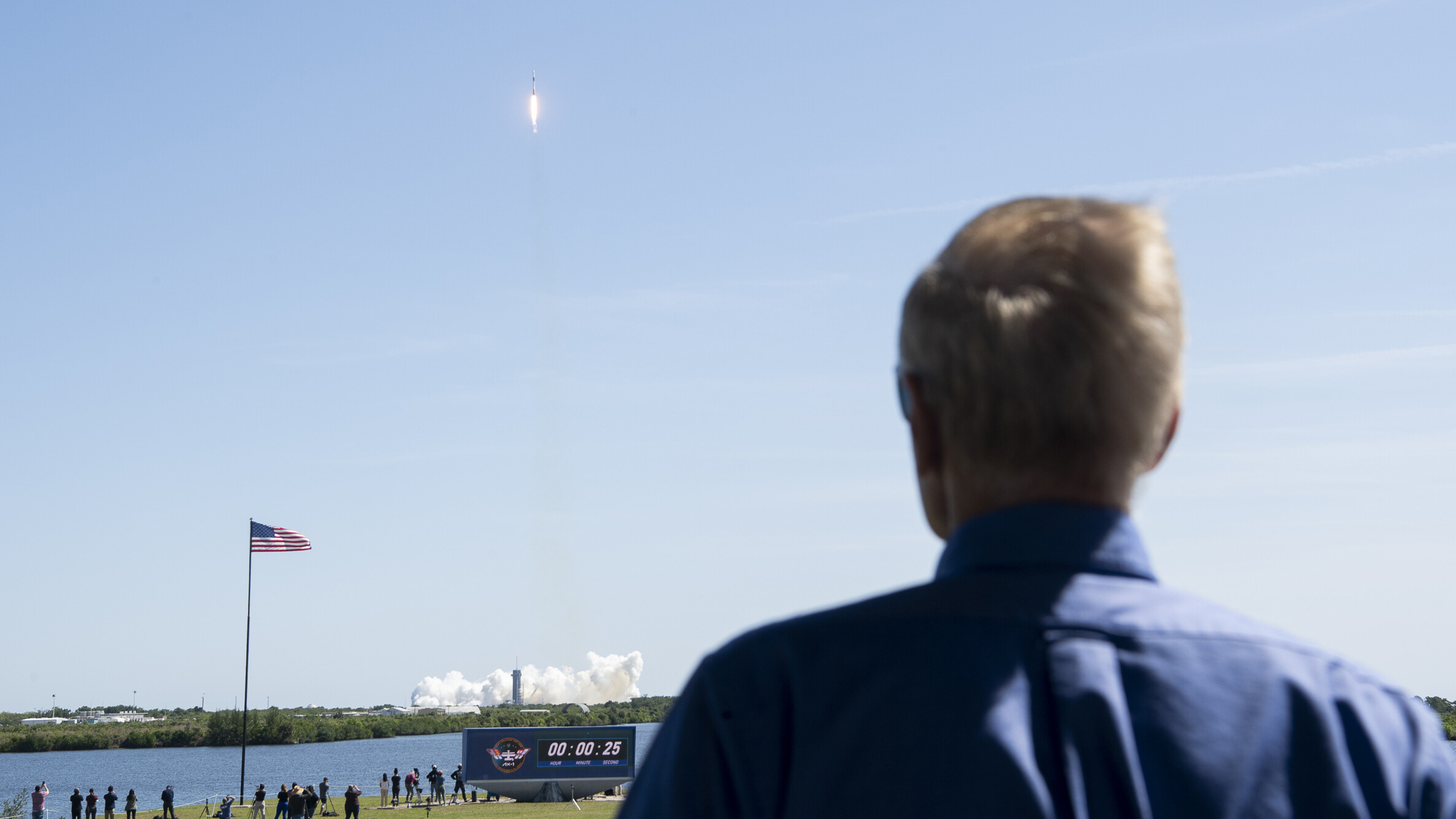
Friday, April 8, 2022: NASA administrator Bill Nelson watches as the first American civilian mission to the International Space Station launches atop SpaceX's Falcon 9 rocket from NASA's Kennedy Space Center in Florida.
The Axiom 1 mission's Crew Dragon capsule with four commercial spacefarers aboard will reach the orbital outpost on Saturday (April 9) at 7:45 a.m. EDT (1145 GMT). The four space travelers (former NASA astronaut Michael López-Alegría, real-estate magnate and acrobatic pilot Larry Connor, music and sustainability entrepreneur Mark Pathy, and investor and former Israel Air Force pilot Eytan Stibbe) will stay at the space station for ten days.
They will join the current crew of three NASA astronauts (Raja Chari, Kayla Barron and Thomas Marshburn), German astronaut Matthias Maurer and three Russian cosmonauts (Sergey Korsakov, Oleg Artemyev and Denis Matveev). – Tereza Pultarova
Milestone missions side by side at NASA's spaceport

Thursday, April 7, 2022: NASA's Space Launch System (SLS) moon rocket and SpaceX Falcon 9, which will launch the first U.S. civilian mission to the International Space Station later this week, stand ready on their launchpads at NASA's Kennedy Space Center in Florida.
NASA shared the image on Twitter, saying this was the first time "two different types of rockets & spacecraft made to carry humans are on the sister pads at the same time."
While SpaceX's Falcon 9 is scheduled to launch the Axiom 1 mission to the International Space Station on Friday (April 8). The SLS rocket is currently waiting for its wet dress rehearsal on launchpad 39B. The wet dress rehearsal is the final pre-launch test designed to take the rocket through the entire pre-launch sequence including countdown. The test was halted earlier this week due to problems with the mobile launcher platform. SLS is expected to lift off for the unmanned Artemis I technology demonstration mission later this year. –Tereza Pultarova
Astronomer snaps newly discovered asteroid zooming past Earth
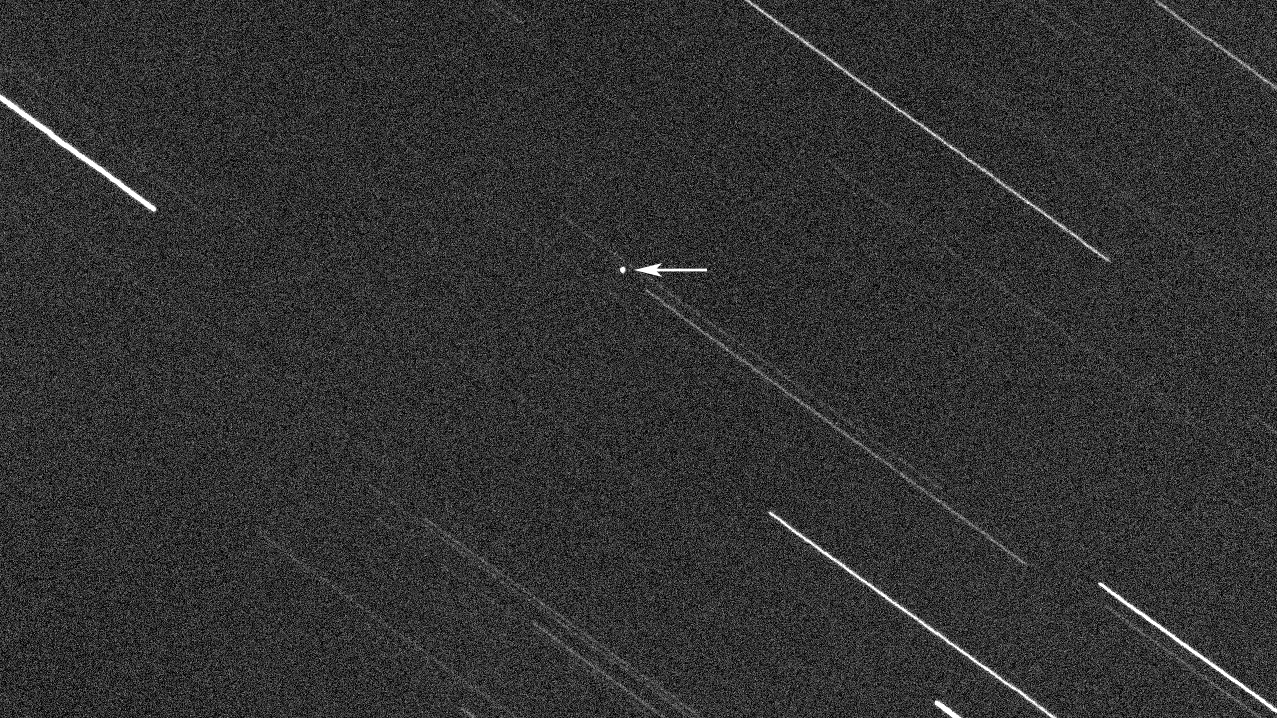
Wednesday, April 6, 2022: An Italian astronomer snapped this image of the 24 to 52 feet (7.2 to16 meters) wide asteroid 2022 GN1 as it zoomed past our planet at about one third of the Earth-moon distance on Wednesday (April 6).
The asteroid, discovered only on Friday (April 1), was never thought to pose any danger to Earth. As predicted, the space rock passed 86,370 miles (139.000 kilometers) from Earth's surface on Wednesday, enticing observers and astrophotographers.
This image, taken about 75 minutes before the asteroid's closest approach, is a result of a 30-second exposure taken remotely by a robotic telescope located in Ceccano, Italy, about 55 miles (90 km) from Rome.
Gianluca Masi, who operates the telescope, said in a statement that the telescope tracked the moving asteroid, which appears as a small dot at the center of the image, with the surrounding stars appearing like long trails. – Tereza Pultarova
Meteor camera reveals scope of satellite pollution

Tuesday, April 5, 2022: A camera looking for falling stars captured a jumble of satellite trails in one of its worst ever nights of satellite pollution.
The camera, located in North Oxfordshire, England, is operated by the UK Meteor Network. In the image, released on Twitter by the camera's owner, skywatcher and science communicator Mary McIntyre, star trails can be seen as curved lines and aircraft trails as dotted lines. The rest are streaks left behind by passing satellites. In the hodgepodge, one can find about 25 meteor streaks.
"Overnight on 2nd3rd April 2022 our southwest facing #RaspberryPi #meteorcamera UK0006 based in North Oxfordshire had one of the worst nights we've ever seen for #satellitetrails," McIntyre said in the tweet. "Just horrendous :("
Meteor cameras survey large portions of the sky in a relatively low resolution, looking for sudden bright streaks caused by space rocks passing through Earth's atmosphere. The long-exposure shots reveal the tracks of everything else that passes through the sky in the given night.
Satellite trails have become a major concern for astronomers especially since SpaceX started launching its Starlink satellite megaconstellation. The trails obscure the view of distant stars and brighten the night sky, making observations more difficult. The problem affects even some of the most pristine locations such as Chile's Atacama Desert. – Tereza Pultarova
Lightning strikes support tower as NASA's moon rocket prepares for test

Monday, April 4, 2022: Four lighting bolts struck the umbilical tower of NASA's Space Launch System rocket on Saturday (April 2) as the powerful booster was being prepared for tests on the launch pad at NASA's Kennedy Space Center in Florida ahead of its debut moon-bound flight later this year. The eerie images were captured on camera by a NASA TV crew.
The 322 feet (98 meters) mega rocket will blast off toward the moon later this year for the uncrewed Artemis I mission, which will serve as a technology demonstration before the first flight with astronauts. The first crewed mission is currently scheduled for 2024.
Three of the strikes, which zapped tower two, were low intensity, NASA said in a statement. The fourth, a higher intensity bolt, struck tower one.
The rocket was rolled out on the launch pad two weeks ago in preparation for its wet dress rehearsal, a final test, during which engineers will fuel the rocket and run it through the entire pre-launch sequence including the countdown.
The engineers, however, decided to halt the tests on Sunday due to problems with fans that maintain pressure in the mobile launcher platform. – Tereza Pultarova
Mesmerizing aurora glows over rural Saskatchewan

Friday, April 1, 2022: This breathtaking view of glowing auroras over the Canadian province of Saskatchewan was captured by nature photographer Jenny Hagan on Wednesday (March 30) after two coronal mass ejections triggered a geomagnetic storm that reinvigorated Earth's polar lights displays.
Jenny, from Eatonia in West Central Saskatchewan, used her Canon 80D camera on a tripod, shooting at 3 second intervals to capture the "lively night sky dancing above me".
"Sights like these are plentiful here in rural Saskatchewan," she told Space.com. "The land of the living sky, and the relics of the past offer up great foreground for the wide open views of our sky. Sitting millions of miles away from us, space modules, satellites, and stars contribute to the light that breaks through the dark."
The mysterious building in the picture is an abandoned 1950s farmhouse near the tiny village of LaPorte, Jenny added. – Tereza Pultarova
Can't find the date you're looking for? It may have been a weekend or holiday, when we don't normally update our Image of the Day.
Click 'NEXT PAGE' below for May >
Join our Space Forums to keep talking space on the latest missions, night sky and more! And if you have a news tip, correction or comment, let us know at: community@space.com.

Space.com is the premier source of space exploration, innovation and astronomy news, chronicling (and celebrating) humanity's ongoing expansion across the final frontier. Originally founded in 1999, Space.com is, and always has been, the passion of writers and editors who are space fans and also trained journalists. Our current news team consists of Editor-in-Chief Tariq Malik; Editor Hanneke Weitering, Senior Space Writer Mike Wall; Senior Writer Meghan Bartels; Senior Writer Chelsea Gohd, Senior Writer Tereza Pultarova and Staff Writer Alexander Cox, focusing on e-commerce. Senior Producer Steve Spaleta oversees our space videos, with Diana Whitcroft as our Social Media Editor.
